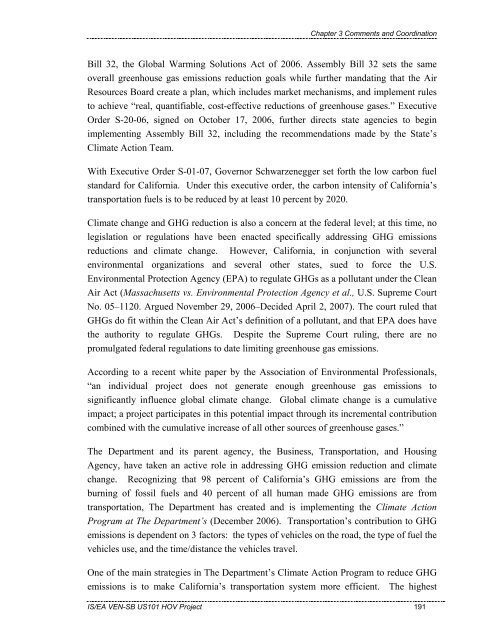Chapter 1 - Caltrans - State of California
Chapter 1 - Caltrans - State of California
Chapter 1 - Caltrans - State of California
Create successful ePaper yourself
Turn your PDF publications into a flip-book with our unique Google optimized e-Paper software.
<strong>Chapter</strong> 3 Comments and Coordination<br />
Bill 32, the Global Warming Solutions Act <strong>of</strong> 2006. Assembly Bill 32 sets the same<br />
overall greenhouse gas emissions reduction goals while further mandating that the Air<br />
Resources Board create a plan, which includes market mechanisms, and implement rules<br />
to achieve “real, quantifiable, cost-effective reductions <strong>of</strong> greenhouse gases.” Executive<br />
Order S-20-06, signed on October 17, 2006, further directs state agencies to begin<br />
implementing Assembly Bill 32, including the recommendations made by the <strong>State</strong>’s<br />
Climate Action Team.<br />
With Executive Order S-01-07, Governor Schwarzenegger set forth the low carbon fuel<br />
standard for <strong>California</strong>. Under this executive order, the carbon intensity <strong>of</strong> <strong>California</strong>’s<br />
transportation fuels is to be reduced by at least 10 percent by 2020.<br />
Climate change and GHG reduction is also a concern at the federal level; at this time, no<br />
legislation or regulations have been enacted specifically addressing GHG emissions<br />
reductions and climate change. However, <strong>California</strong>, in conjunction with several<br />
environmental organizations and several other states, sued to force the U.S.<br />
Environmental Protection Agency (EPA) to regulate GHGs as a pollutant under the Clean<br />
Air Act (Massachusetts vs. Environmental Protection Agency et al., U.S. Supreme Court<br />
No. 05–1120. Argued November 29, 2006–Decided April 2, 2007). The court ruled that<br />
GHGs do fit within the Clean Air Act’s definition <strong>of</strong> a pollutant, and that EPA does have<br />
the authority to regulate GHGs. Despite the Supreme Court ruling, there are no<br />
promulgated federal regulations to date limiting greenhouse gas emissions.<br />
According to a recent white paper by the Association <strong>of</strong> Environmental Pr<strong>of</strong>essionals,<br />
“an individual project does not generate enough greenhouse gas emissions to<br />
significantly influence global climate change. Global climate change is a cumulative<br />
impact; a project participates in this potential impact through its incremental contribution<br />
combined with the cumulative increase <strong>of</strong> all other sources <strong>of</strong> greenhouse gases.”<br />
The Department and its parent agency, the Business, Transportation, and Housing<br />
Agency, have taken an active role in addressing GHG emission reduction and climate<br />
change. Recognizing that 98 percent <strong>of</strong> <strong>California</strong>’s GHG emissions are from the<br />
burning <strong>of</strong> fossil fuels and 40 percent <strong>of</strong> all human made GHG emissions are from<br />
transportation, The Department has created and is implementing the Climate Action<br />
Program at The Department’s (December 2006). Transportation’s contribution to GHG<br />
emissions is dependent on 3 factors: the types <strong>of</strong> vehicles on the road, the type <strong>of</strong> fuel the<br />
vehicles use, and the time/distance the vehicles travel.<br />
One <strong>of</strong> the main strategies in The Department’s Climate Action Program to reduce GHG<br />
emissions is to make <strong>California</strong>’s transportation system more efficient. The highest<br />
IS/EA VEN-SB US101 HOV Project 191

















